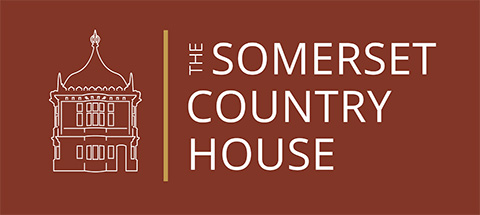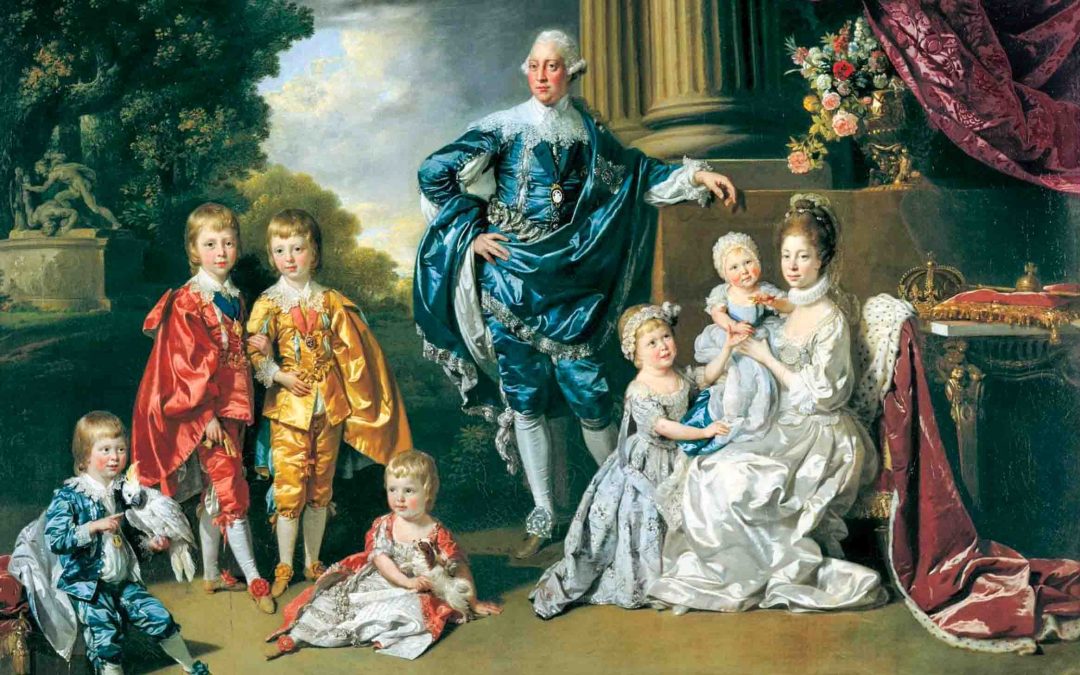Main Photo Source: ‘George III (1738-1820), Queen Charllotte (1744-1818) and their Six Eldest Children’ by Johann Zoffany, Royal Collection. Source: Wikimedia Commons.[i]
In the Commonplace book of Edward Phelips[ii] there are two poems about George III. The first poem, written by Edward Phelips V (1725-1797) in 1770 exalts the virtues of the king, who had been on the throne for 10 years. Phelips took his place in national politics as MP for Somerset from 1774 until 1780. When he wrote his poem at the age of 45, he was still ambitious to take a seat and had spent his formative years establishing his position in the Somerset gentry, taking his seat at Montacute and supporting his young family. His attitude towards the king may have been romantically naïve or a stance for his ambition. It is not known if anyone else read it.
“On the King, 1770[iii]
(Phelips)
Is there a Sovereign, seated on a throne,
Who makes the interest of mankind his own,
Stranger to partial ties of time, and place,
Who nobly feels for all the human race;
With whom a mild humanity resides,
Which virtue dictates and which prudence guides;
With wisdom fraught, beyond the reach of youth,
To explore the secret springs of worth, and truth;
Whose acts are circumscribed to reasons sphere,
No slave to passion, nor no dupe to fear;
With heart capacious, and with bounteous mind,
At once to govern, and to bless mankind!
Tho’ party prejudice, his actions scan,
And magnify each failing of the Man;
The muse unblamed, may sure, such virtues sing,
And plant untainted laurels round the King.”
Edward (1725-1797) was 13 years older than George III (1738-1820). The ageing George II had been king since Edward‘s birth and died in 1760 at the age of 76. Not necessarily an inspiration for a young man, but George III had promise upon his accession at the age of 22. Edward wanted to be part of the established gentry and the new culture of sensibilities and family was coming from the top. George had himself portrayed as a family man. The portrait of George III (1738-1820), Queen Charlotte (1744-1818), and their Six Eldest Children was painted in 1770 by Johan Joseph Zoffany (1733-1810).[iv]
The second poem, written 9 years later in 1779 has a very different attitude towards the king. The name ‘Wallwyn’ is in the margin and presumably that is the author and Phelips just transcribed into his commonplace book. There was an MP called James Walwyn (1744-1800) of Longworth Hall, Lugwardine, Herefordshire. Otherwise, I cannot find someone called ‘Walwyn’ or ‘Wallwyn’ who wrote satirical poems. As it is transcribed in Phelip’s commonplace book it has to the potential to represent his altered opinion of the king. Phelip’s own poetry tends to be rather lyrical with classical allusions. This poem is rather basic in its humour and not of his style. However, it must have appealed to him to record it.
“On the King’s Accession[v]
October 25 1779[vi]
(Wallwyn)
Again the Bells salute my Ear,
Georgy begins his twentieth year!
Exactly nineteen years ago
His Granny took a turn below.[vii]
While George the Second there lies Stewing,[viii]
What Here has George the third been doing.
Why George has lost – Thirteen Provinces[ix]
And George has got – as many Princes[x]
And George has lost – a virtuous sister[xi]
And George has got – a wife Mi-nister
And George has lost – a foe at Rome[xii]
And George has got – no friends at home
And George has eat – a world of muttons
And George has turned – a world of Buttons
And George has laid – a world of Taxes
And George has got – his Dolls and go-carts[xiii]
And George has lost – his people’s hearts
Then let us hail own King’s Accession,
And two years hence, let’s hope Discretion!
Then Georgy comes – to one and twenty
Then Welcome peace, and welcome plenty;
Then bit adieu to Childish farces,
And France, and Spain, may kiss our Arses.”
Lord North was Prime Minster from 1770 to 1782 and was unfortunately known for losing the American colonies and thought of as being a puppet of the king. Lord North was a near neighbour with a country seat at Dillington House less than 10 miles away from Montacute House. To my knowledge Edward V did not socialise with Lord North. He does mention meeting him at the Ilminster turnpike in August 1759:
“Met Lord North at Ilminster on the Turnpike”[xiv]
I get the impression that Edward Phelips was not a friend or admirer of Lord North. Maybe further research will uncover more!
NOTES
[i] ‘George III (1738-1820), Queen Charllotte (1744-1818) and their Six Eldest Children’ by Johann Zoffany (1733-1810), 1770, Royall Collection, Wikimedia Commons, https://commons.wikimedia.org/wiki/File:Johan_Joseph_Zoffany_(Frankfurt_1733-London_1810)_-_George_III_(1738-1820),_Queen_Charlotte_(1744-1818)_and_their_Six_Eldest_Children_-_RCIN_400501_-_Royal_Collection.jpg[accessed 28 July 2023].
[ii] Somerset Heritage Centre, ‘Commonplace book of Edward Phelips of Montacute. c. 1770s-1780s’, Stevens Cox Collection, Estate, manorial and household, Phelips family of Montacute, A/CTP/3/3/2.
[iii] Somerset Heritage Centre, ‘Commonplace book of Edward Phelips of Montacute. c. 1770s-1780s’, A/CTP/3/3/2.
[iv] ‘The portrait of George III (1738-1820), Queen Charlotte (1744-1818), and their Six Eldest Children’, Royal Collection Trust, https://www.rct.uk/collection/400501/george-iii-1738-1820-queen-charlotte-1744-1818-and-their-six-eldest-children [accessed 17 July 2023].
[v] Somerset Heritage Centre, ‘Commonplace book of Edward Phelips of Montacute. c. 1770s-1780s’, A/CTP/3/3/2.
[vi] George III’s accession was on the 25th of October 1760
[vii] Caroline of Ansbach (1683-1737) was George III’s grandmother.
[viii] George II (1683-1760) was George III’s grandfather.
[ix] Britain had 13 colonies on the east coast of America. They declared themselves independent in 1776.
[x] George III and Queen Charlotte had 15 children: 6 daughters and 9 sons.
[xi] His virtuous sister may have been Princess Elizabeth who did some acting and died at the young age of 18.
[xii] This probably is reference to ‘the Old Pretender’: James Francis Edward Stuart. He was James II’s son by his 2nd wife, Mary of Modena. He died at Palazzo Muti in Rome on 1 January 1766.
[xiii] Go-carts may refer to infant carriages.
[xiv] Somerset Heritage Centre, ‘Diary of Edward Phelips of Montacute House. 1 Jan 1779-31 Dec 1779’, Stevens Cox Collection, Estate, manorial and household, Phelips family of Montacute, A/CTP/3/3/1.

